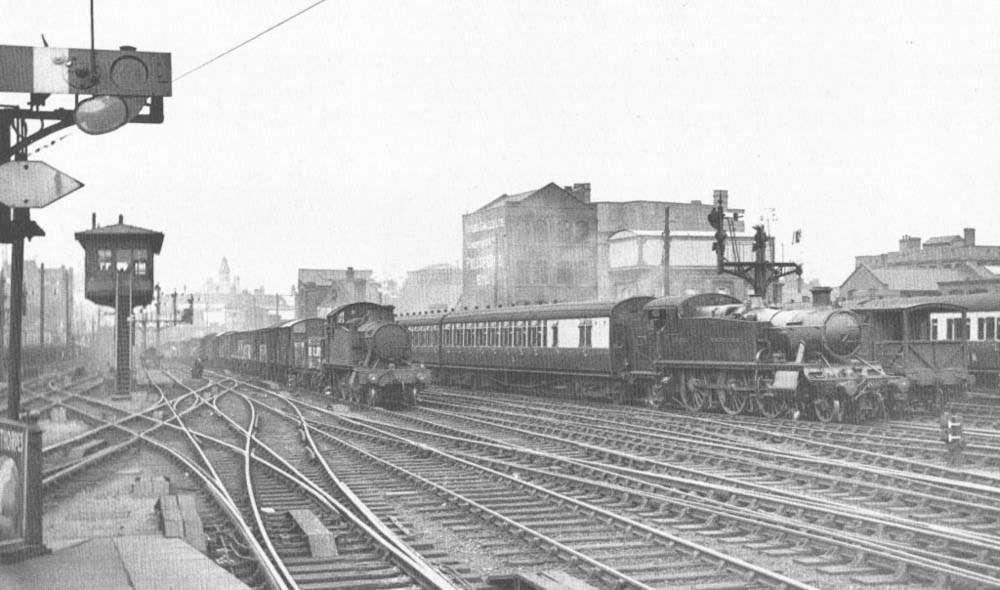 |
|
GWR Route: Banbury to Wolverhampton
GWR Route: North Warwickshire Line
Birmingham Snow Hill Station: gwrbsh1777
 |
Prairie tank engines were the mainstay of the local freight
and suburban passenger services in the Birmingham Division and here two up
trains headed by this type of locomotive passing Birmingham North Signal Box as
they approach the north end of Birmingham Snow Hill station on Friday 7th
September 1934. On the up through main line is Great Western Railway 4575 class
small prairie 2-6-2T No 4579 heading a class K ordinary freight to Bordesley
Junction. While Great Western Railway 5101 class large prairie 2-6-2T No 5167
brings one of the four coach Divisional ‘A’ Sets to Platform No 11 to
form the 12:47 p.m. local to Leamington Spa. These are some of the sixteen,
seventy foot long, steel panelled, non-corridor toplight coaches built in
November 1913, which belonged to the Birmingham Divisional 'A' Sets Nos 5, 6, 7
and 8. Next to the locomotive is a brake third coach to diagram D55 (lot 1227).
This had eight third class compartments, a guard’s compartment and luggage
area. The coach running numbers were 1070 to 1077. Adjacent to this is a
composite coach to diagram E97 (lot 1226). These had coach running numbers 6863
to 6870. These four coach sets spent almost their entire service life allocated
to the Birmingham Division being eventually condemned in December 1956. They
have the distinction of being the only seventy foot long non-corridor coaches
to run on an English Railway and were the first vehicles on the Great Western
Railway to have fireproof floors.
Locomotive No 5167 was built in December 1930 at Swindon
Works as part of lot 259. These were an updated version of the 51xx class with
curved drop frames, outside steam pipes, lower cab height and enlarged coal
bunkers with a capacity of four tons. The tanks held 2,000 gallons of water.
The locomotives were four tons heavier than their predecessors and had a
maximum axle weight of 17 tons, 12 cwt, which restricted them to main lines and
some branch lines (Route colour Blue). They had the same Standard No 2 boiler,
which was fitted with 12 / 48 superheating and topfeed apparatus. The boiler
pressure was 200 lbs and the tractive effort at 85% was 24,300 lb. This placed
the locomotive in power group D. The majority of the 5101 class locomotives
were allocated to the Wolverhampton Division, where their fast acceleration
made them ideal for operating the region's suburban passenger services. They
were eventually displaced by the arrival of Diesel Multiple Units (DMUs) in the
late 1950s. No 5167 was initially allocated to Stafford Road shed (SRD) in
Wolverhampton, but was known to have been allocated to Leamington shed (LMTN)
in January 1934. In January 1938, No 5167 was known to have been allocated back
at Stafford Road shed. Prior to nationalisation in December 1947, No 5167 was
allocated to Stourbridge shed (STB) and was still allocated there in August
1950. No 5167 was eventually withdrawn from Banbury shed (84C) in January
1962.
Locomotive No 4579 was built in February 1927 at Swindon
Works as part of lot 242. The 4575 class locomotives were a development of the
45xx class, the first one of which had been built in 1906 for branch line use.
They had the same Standard No 5 boiler, which was fitted with superheating and
topfeed apparatus, but had; larger side tanks capable of holding 1,300 gallons
of water (these tanks had a sloping top to improve visibility), a flanged
motion bar cross frame, outside steam pipes and curved front drop ends (these
last two features had actually been introduced in the earlier 1924 batch). The
weight had increased and the maximum axle weight was 15 tons, 11 cwt, which
restricted them to main lines and most branch lines (route colour yellow). The
boiler pressure was 200 lbs and the tractive effort at 85% was 21,250 lb, which
placed the locomotive in power group C. The 4575 class were mainly allocated as
replacements for nineteenth century tank and tender locomotives on the West
Midland Railway branch lines and No 4579 was originally allocated to Tyseley
shed (TYS). The locomotive was also known to have been allocated there in
January 1934. In January 1938, No 4579 was known to have been allocated to
Whitland shed (WTD), was also allocated there prior to nationalisation in
December 1947 and was withdrawn from Whitland shed, which was then a sub-shed
to Neyland (87H) in September 1958.
Robert Ferris
 back back

|
